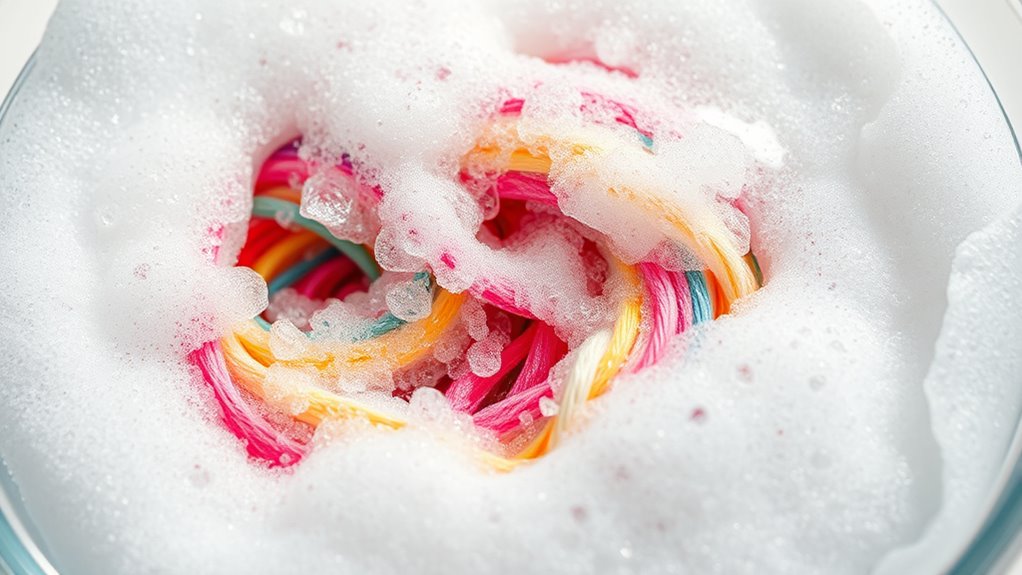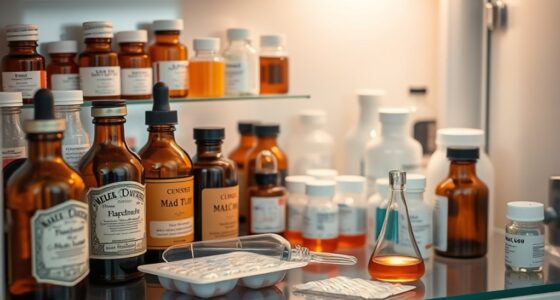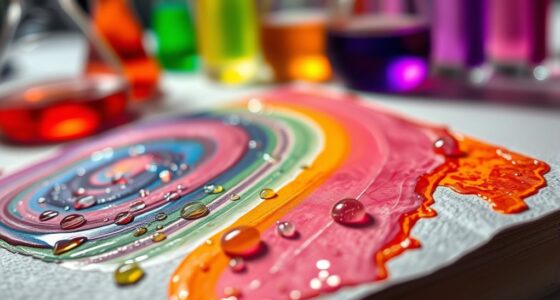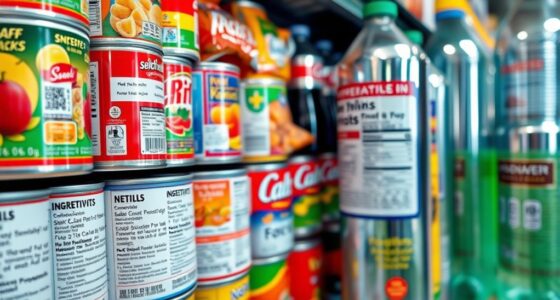Surfactants are key ingredients in household detergents that help you remove dirt, grease, and oils effectively. They work by breaking down the surface tension between water and grime, surrounding and lifting away stubborn stains through emulsification. Different types target specific cleaning needs, from gentle formulas for delicate surfaces to strong ones for greasy messes. Understanding how surfactants work can help you choose better products—keep going to discover more about eco-friendly options and sustainable cleaning.
Key Takeaways
- Surfactants remove dirt and grease by breaking down oils and lowering water surface tension.
- They form micelles that trap grime, allowing it to be rinsed away easily.
- Different surfactant types (anionic, nonionic, cationic) target specific cleaning needs.
- Surfactants enhance foam, improve cleaning efficiency, and aid rinsing in household detergents.
- Eco-friendly surfactants promote sustainable cleaning by reducing environmental impact.
What Are Surfactants and How Do They Work?

Surfactants are the key ingredients in household detergents that help remove dirt and grease. Understanding surfactant chemistry reveals how these molecules work—each has a hydrophobic tail and a hydrophilic head, which allows them to break up and lift greasy stains. Historically, the development of surfactants began with early soapmaking, evolving into synthetic options during the 20th century to improve cleaning efficiency and stability. This progression reflects a deeper understanding of their molecular behavior and their ability to lower surface tension between water and oils. Today, surfactants are carefully designed to maximize cleaning power while being gentle on surfaces and skin. Additionally, ongoing research into environmentally friendly surfactants aims to reduce ecological impact without compromising cleaning performance. The formulation of surfactants also considers biodegradability, which is vital for minimizing environmental pollution. These advances demonstrate the importance of innovative formulations in creating effective and sustainable cleaning solutions.
Types of Surfactants Used in Household Cleaning Products

Household cleaning products incorporate various types of surfactants, each designed to target specific cleaning tasks. You’ll find biodegradable surfactants in many eco-friendly formulas, which break down more easily in the environment and reduce pollution. These surfactants are popular because they minimize surfactant toxicity, making them safer for both your family and the planet. Anionic surfactants, often used in laundry detergents, excel at removing dirt and grease, while nonionic surfactants are gentle and effective in delicate surfaces. Cationic surfactants are common in disinfectants and fabric softeners, offering antimicrobial properties. By understanding these types, you can choose cleaning products that are both effective and environmentally conscious, ensuring your cleaning routine aligns with safety and sustainability goals. HEPA filters are also used in air purifiers to improve indoor air quality, helping to remove allergens and pollutants from your environment. Additionally, selecting appropriate surfactant types based on your specific cleaning needs can enhance overall efficiency and safety of household chores. Proper selection of surfactants based on their chemical properties can significantly improve cleaning results and reduce potential health risks.
The Cleaning Process: How Surfactants Break Down Dirt and Grease
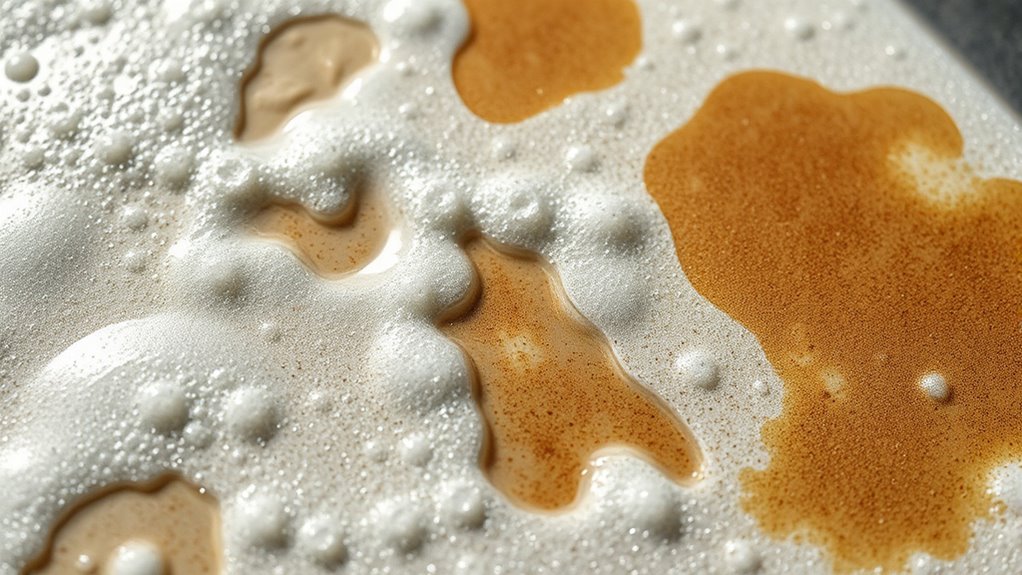
When you use a detergent, surfactants work by lowering the surface tension between water, dirt, and grease. They surround and lift away stubborn grime through a process called emulsification, where oils and fats are broken into tiny droplets. This makes it easier for water to wash away the dirt, leaving your surfaces clean.
Surfactant Action Mechanism
Because dirt and grease are often stubbornly attached to surfaces, surfactants work by actively surrounding and lifting these particles away from fabrics and surfaces. This process begins with surfactant molecules, whose structure features a hydrophobic tail and hydrophilic head. When you add detergent, micelle formation occurs: the tails cluster inward, trapping grease and dirt, while the heads face outward, allowing the particles to stay suspended in water. This mechanism ensures that grime is loosened and lifted away during rinsing. To understand better:
- The unique surfactant structure enables effective micelle formation, encapsulating dirt.
- Active surfactant molecules reduce surface tension, loosening particles.
- Micelles keep dirt suspended, preventing re-deposition on fabrics or surfaces.
Dirt and Grease Breakdown
Surfactants actively break down dirt and grease by disrupting their structural integrity, allowing particles to loosen and wash away. They surround oily residues, forming micelles that trap grease within their cores. However, biodegradability challenges can hinder environmental breakdown, raising concerns about long-term pollution. Additionally, surfactant toxicity may affect aquatic life if not properly managed. The biodegradability of surfactants plays a crucial role in their environmental impact. The environmental persistence of non-biodegradable surfactants can lead to accumulation in ecosystems, exacerbating pollution issues. This persistence can result in long-term environmental contamination, impacting soil and water quality. Here’s a comparison of key factors:
| Aspect | Impact |
|---|---|
| Biodegradability | Affects environmental persistence |
| Toxicity | Influences aquatic safety |
| Effectiveness | Breaks down stubborn dirt and grease |
| Residuals | May remain if not biodegradable |
| Environmental concerns | Drive formulation improvements |
Understanding these factors helps balance cleaning power with ecological responsibility.
Emulsification Process
Have you ever wondered how surfactants manage to lift stubborn dirt and grease from surfaces? The secret lies in the emulsification process. When surfactants encounter oil and water, they form micelles at the oil-water interface. This process traps grease and dirt inside tiny spheres, making them easier to rinse away. Here’s how it works:
- Surfactants align at the oil water interface, reducing surface tension.
- Micelle formation encases dirt and grease, stabilizing them in water.
- These micelles suspend the particles, preventing them from re-depositing on surfaces.
Environmental Considerations and Sustainable Alternatives
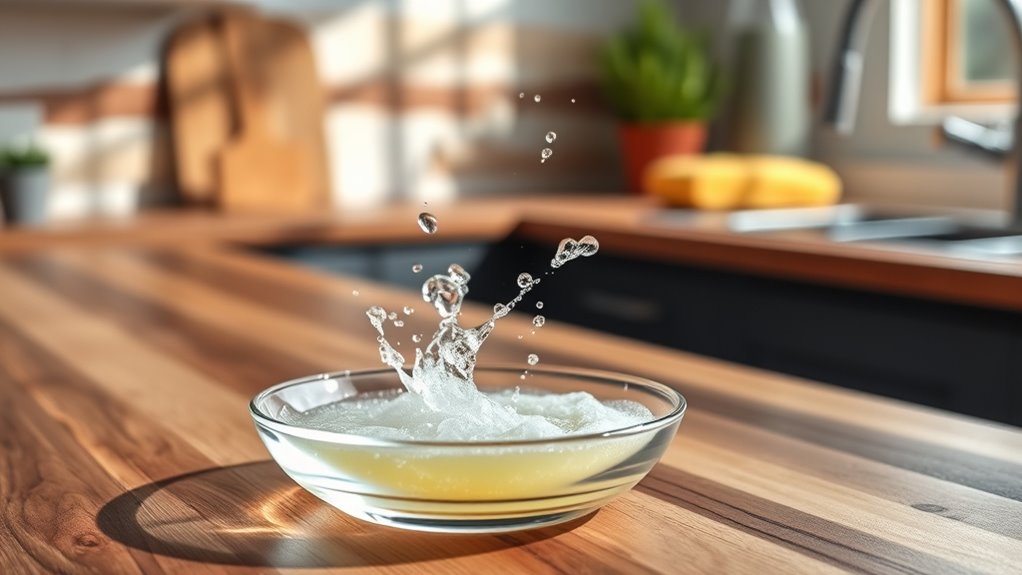
As awareness of environmental impacts grows, many consumers are seeking sustainable alternatives to traditional surfactants in household detergents. You might notice a shift toward ingredients with better biodegradability concerns, meaning they break down more quickly and safely in the environment. Eco-friendly manufacturing processes also appeal to those wanting to reduce their ecological footprint, using renewable resources and reducing harmful emissions. These alternatives often avoid phosphates and synthetic chemicals that can pollute waterways. By choosing products with biodegradable surfactants and sustainable production methods, you contribute to less water and soil pollution. This movement toward greener options helps protect ecosystems and reduces the long-term environmental impact of your cleaning routine, aligning your household choices with a more sustainable future. Additionally, incorporating natural materials in product formulation can further enhance biodegradability and environmental safety. Emphasizing biodegradable surfactants can lead to more environmentally responsible cleaning practices and support the development of sustainable cleaning products.
Common Household Products Containing Surfactants

You’ll find surfactants in many household products designed for cleaning and personal care. These include items you use daily, such as laundry detergents, fabric softeners, and body washes. Understanding what’s inside helps you make better choices:
Surfactants are common in household cleaners, softeners, and personal care products you use daily.
- Laundry Detergents – Surfactants play a key role in removing stains and dirt, aiding in effective laundry stain removal.
- Fabric Softeners – They contain surfactants that coat fibers, softening fabrics and reducing static cling.
- Personal Care Products – Shampoos and body washes rely on surfactants for cleansing your skin and hair.
Additionally, being aware of the presence of surfactants can help you select products that align with your organization and decluttering goals, promoting a more mindful approach to household cleaning.
Tips for Choosing Eco-Friendly Detergents

Choosing eco-friendly detergents starts with reading labels carefully to identify products that prioritize environmental safety. Look for certifications or labels indicating biodegradability, addressing biodegradability concerns and ensuring the detergent breaks down naturally without harming ecosystems. Opt for detergents with plant-based ingredients, which are generally more sustainable and less toxic than synthetic alternatives. These ingredients often produce fewer harmful residues and are gentler on your skin and the environment. Avoid products with unnecessary chemicals or artificial fragrances, as they can contribute to pollution and harm aquatic life. Additionally, selecting user-friendly detergents can make the transition to eco-friendly cleaning easier for consumers. Incorporating biodegradable formulas helps reduce plastic waste and pollution, further supporting sustainability efforts. Using the right type of detergent kettle can also improve cleaning efficiency and energy use in household chores. By selecting detergents with biodegradable formulas and plant-based components, you support sustainability and reduce your ecological footprint. Making informed choices helps protect the environment while keeping your home clean effectively.
Frequently Asked Questions
Are Surfactants Safe for Sensitive Skin and Allergies?
You might wonder if surfactants are safe for sensitive skin and allergies. Many products now use hypoallergenic formulations and allergy-resistant ingredients to minimize irritation. However, some surfactants can still cause reactions, so it is crucial to read labels carefully. If you have sensitive skin, opt for detergents specifically designed for allergies, and consider testing a small area first. Choosing gentle, dermatologist-recommended options helps protect your skin health.
How Do Surfactants Affect Water Quality After Washing?
Imagine a mountain of suds spilling into your water after washing—surfactants do that. They can profoundly impact water quality by contributing to water pollution and disrupting aquatic life. Their environmental impact gets worse when detergents aren’t biodegradable, leaving residues that threaten ecosystems. So, you should choose eco-friendly options, as surfactants affect water quality long after your laundry’s done, making a big difference in protecting our planet.
Can Surfactants Cause Skin Irritation or Respiratory Issues?
You might experience skin irritation or respiratory issues if you’re sensitive to chemicals in surfactants, especially with long-term exposure. These substances can sometimes trigger chemical sensitivities, leading to discomfort or allergic reactions. To minimize risks, it’s smart to wear gloves when handling detergents and guarantee good ventilation. If symptoms persist, consult a healthcare professional, as prolonged exposure could worsen skin or respiratory problems.
What Innovations Are Emerging in Eco-Friendly Surfactants?
Bringing breakthrough benefits, eco-friendly surfactants are evolving rapidly. You’ll notice new biodegradability innovations that guarantee your cleaning is gentle on the planet. Plant-based formulations are popping up, prioritizing sustainability without sacrificing cleaning power. These innovations reduce environmental impact, promote safer skin contact, and support eco-conscious choices. As these advancements advance, you’ll enjoy effective cleaning with a clear conscience, knowing you’re helping protect our planet for future generations.
Are Natural Surfactants as Effective as Synthetic Ones?
You might wonder if natural surfactants are as effective as synthetic ones. Generally, natural surfactant sources like plant oils offer biodegradability benefits, making them eco-friendly. While they can be just as powerful for cleaning, their effectiveness depends on formulation and concentration. Natural surfactants often require more careful formulation but provide sustainable cleaning options without compromising performance, making them a good alternative for eco-conscious users.
Conclusion
Think of surfactants as tiny knights wielding their cleaning swords, fighting dirt and grease on your behalf. When you choose eco-friendly options, you’re sending in noble warriors committed to protecting your home and the planet. By understanding their role, you become the wise ruler, guiding your household’s cleaning battles wisely. With conscious choices, you assure a sparkling home and a healthier Earth, much like tending a beautiful garden that flourishes under your care.
